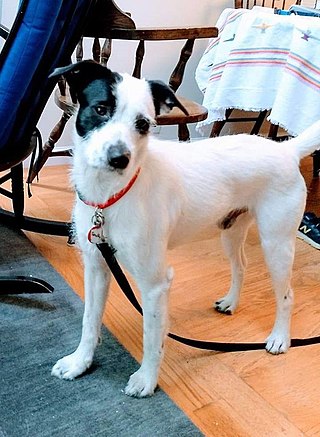
The Basenji is a breed of hunting dog. It was bred from stock that originated in central Africa. The Fédération Cynologique Internationale places the breed in the Spitz and primitive types. The Basenji produces an unusual yodel-like sound, due to its unusually shaped larynx. This trait also gives the Basenji the nickname the 'barkless dog.'

The Siberian Husky is a medium-sized working sled dog breed. The breed belongs to the Spitz genetic family. It is recognizable by its thickly furred double coat, erect triangular ears, and distinctive markings, and is smaller than the similar-looking Alaskan Malamute.

A dog breed is a particular strain of dog that was purposefully bred by humans to perform specific tasks, such as herding, hunting, and guarding. Dogs are the most variable mammal on Earth, with artificial selection producing around 450 globally recognized breeds. These breeds possess distinct traits related to morphology, which include body size, skull shape, tail phenotype, fur type, body shape, and coat colour. Their behavioral traits include guarding, herding, and hunting, and personality traits such as hyper-social behavior, boldness, and aggression. Most breeds were derived from small numbers of founders within the last 200 years. As a result, today dogs are the most abundant carnivore species and are dispersed around the world.

The Shetland Sheepdog, often known as the Sheltie, is a breed of herding dog that originated in the Shetland Islands of Scotland. The original name was Shetland Collie, but this caused controversy amongst Rough Collie breeders of the time, so the breed's name was formally changed. This diligent small dog is clever, vocal, excitable and willing to please. They are incredibly trustworthy to their owners to the point where they are often referred to as "shadows" due to their attachment to family. This breed was formally recognized by The Kennel Club (UK) in 1909.

A Schipperke is a small breed of dog that is believed to have originated in the 1600s in Belgium. There has been a long informal debate over whether this type of dog is a spitz or miniature sheepdog. In their home country of Belgium they are considered a small shepherd. DNA research has shown that Schipperkes have a close relationship to the Spitz family of dog breeds.

A mongrel, mutt or mixed-breed dog is a dog that does not belong to one officially recognized breed and including those that are the result of intentional breeding. Although the term mixed-breed dog is sometimes preferred, many mongrels have no known purebred ancestors. Crossbreed dogs, and "designer dogs", while also a mix of breeds, differ from mongrels in being intentionally bred. At other times, the word mongrel has been applied to informally purpose-bred dogs such as curs, which were created at least in part from mongrels, especially if the breed is not officially recognized.

Husky is a general term for a dog used in the polar regions, primarily and specifically for work as sled dogs. It refers to a traditional northern type, notable for its cold-weather tolerance and overall hardiness. Modern racing huskies that maintain arctic breed traits represent an ever-changing crossbreed of the fastest dogs.

The Greenland Dog is a large breed of husky-type dog kept as a sled dog. They were brought from Siberia to North America by the Thule people 1,000 years ago, along with the Canadian Eskimo Dog. The Canadian Eskimo Dog is considered the same breed as the Greenland Dog since they have not yet diverged enough genetically to be considered separate breeds, despite their geographic isolation.

The Carolina dog, also known as a yellow dog, yaller dog, American Dingo, or Dixie Dingo, is a breed of medium-sized dog occasionally found feral in the Southeastern United States, especially in isolated stretches of longleaf pines and cypress swamps. Efforts to establish them as a standardized breed has gained the Carolina Dog breed recognition in two smaller kennel clubs and full acceptance into the breed-establishment program of one major kennel club.
Canid hybrids are the result of interbreeding between the species of the genus Canis. This often occurs in the wild, and in particular between domestic or feral dogs with wild native canids.

The Dutch Shepherd is a herding dog of Dutch origin. They were used by shepherds and farmers who needed a versatile dog, with few demands, and a dog that was able to adapt to a harsh and meager existence.
Animal breeding is a branch of animal science that addresses the evaluation of the genetic value of livestock. Selecting for breeding animals with superior EBV in growth rate, egg, meat, milk, or wool production, or with other desirable traits has revolutionized livestock production throughout the entire world. The scientific theory of animal breeding incorporates population genetics, quantitative genetics, statistics, and recently molecular genetics and is based on the pioneering work of Sewall Wright, Jay Lush, and Charles Henderson.
Progressive retinal atrophy (PRA) is a group of genetic diseases seen in certain breeds of dogs and, more rarely, cats. Similar to retinitis pigmentosa in humans, it is characterized by the bilateral degeneration of the retina, causing progressive vision loss culminating in blindness. The condition in nearly all breeds is inherited as an autosomal recessive trait, with the exception of the Siberian Husky (inherited as an X chromosome linked trait) and the Bullmastiff (inherited as an autosomal dominant trait). There is no treatment.

Cerebellar abiotrophy (CA), also called cerebellar cortical abiotrophy (CCA), is a genetic neurological disease in animals, best known to affect certain breeds of horses, dogs and cats. It can also develop in humans. It develops when the neurons known as Purkinje cells, located in the cerebellum of the brain, begin to die off. These cells affect balance and coordination. They have a critical role to play in the brain. The Purkinje layer allows communication between the granular and molecular cortical layers in the cerebellum. Put simply, without Purkinje cells, an animal loses its sense of space and distance, making balance and coordination difficult. People with damage to the cerebellum can experience symptoms like unsteady gait, poor muscle control, and trouble speaking or swallowing.
Exercise-induced collapse (EIC) is a genetic disorder that causes dogs of certain breeds to collapse after a period of intense exercise. The breeds affected are primarily sporting dogs.

The horse genome was first sequenced in 2006. The Horse Genome Project mapped 2.7 billion DNA base pairs, and released the full map in 2009. The horse genome is larger than the dog genome, but smaller than the human genome or the bovine genome. It encompasses 31 pairs of autosomes and one sex chromosome pair.

Ann Trommershausen Bowling was an American scientist who was one of the world's leading geneticists in the study of horses, conducting research in the areas of molecular genetics and cytogenetics. She was a major figure in the development of testing to determine animal parentage, first with blood typing in the 1980s and then DNA testing in the 1990s. She later became known for her studies of hereditary diseases in horses and equine coat color genetics, as well as research on horse evolution and the development of horse breeds. She studied the population genetics of feral horses, did considerable work to help preserve the Przewalski's horse, and was one of the founding members of the international project to map the horse genome. She was an adjunct professor at the University of California, Davis (UCD), and at the time of her death in 2000 was the executive associate director of the Veterinary Genetics Laboratory (VGL) there. Her unexpected death on December 8, 2000, at age 57 was attributed to a massive stroke.

Elaine Ann Ostrander is an American geneticist at the National Human Genome Research Institute (NHGRI) of the National Institutes of Health (NIH) in Bethesda, Maryland. She holds a number of professional academic appointments, currently serving as Distinguished and Senior Investigator and head of the NHGRI Section of Comparative Genomics; and Chief of the Cancer Genetics and Comparative Genomics Branch. She is known for her research on prostate cancer susceptibility in humans and for conducting genetic investigations with the Canis familiaris —the domestic dog— model, which she has used to study disease susceptibility and frequency and other aspects of natural variation across mammals. In 2007, her laboratory showed that much of the variation in body size of domestic dogs is due to sequence changes in a single gene encoding a growth-promoting protein.

The Alaskan husky is a breed of medium-sized working sled dog, developed specifically for its performance as such.
Matt Salzberg is a businessperson and entrepreneur, known for co-founding Blue Apron, Embark Veterinary and Suma Brands. He is currently founder and Managing Partner at Material, a venture fund focused on systematic company creation opportunities.















